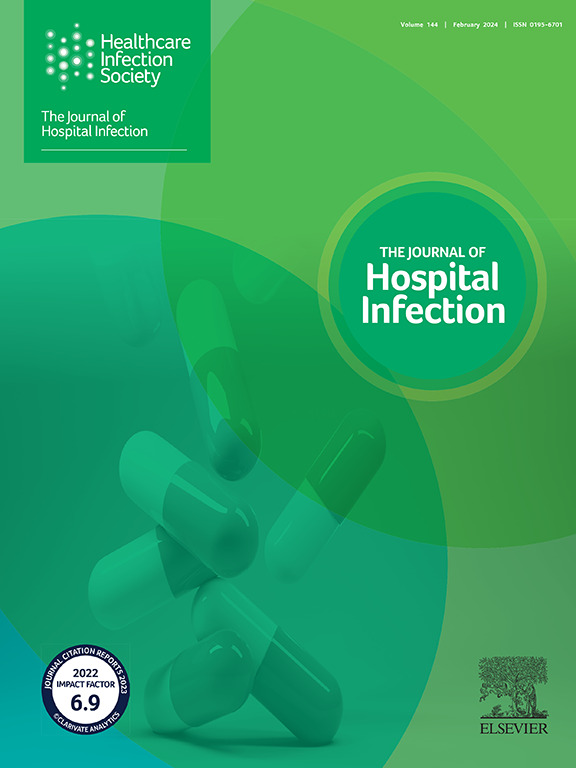Origin and transmission of carbapenemase-producing Enterobacterales and vancomycin-resistant enterococci in hospitalized patients: a genomic and epidemiological analysis
IF 3.1
3区 医学
Q1 INFECTIOUS DISEASES
引用次数: 0
Abstract
Background
Antimicrobial resistance is an emerging threat, with carbapenemase-producing Enterobacterales (CPE) and vancomycin-resistant enterococci (VRE) posing substantial challenges. This study investigated CPE/VRE acquisition and spread in hospitalized patients by analysing resistance genes and microbiomes using whole-genome sequencing (WGS), and exploring epidemiological and clinical risk factors.
Methods
This retrospective study included patients from the infectious disease department of a tertiary hospital. Stool samples were collected weekly, together with clinical and epidemiological information. Those in which CPE/VRE were isolated underwent WGS to evaluate the presence of resistance genes. Microbiome analysis was performed at admission and discharge. WGS was also performed for all positive samples collected within the hospital during the study period.
Results
Of the 102 participants, 16 (15.7%) had CPE/VRE at admission. Key risk factors for harbouring CPE/VRE at admission included recent hospitalization, surgery and antibiotic use. The first week of hospitalization was critical for acquiring CPE/VRE, with dementia, central or urinary catheters, and carbapenem use being significant risk factors. CPE/VRE acquired post-admission shared resistance genes with circulating hospital strains, whereas those present at admission featured novel genes such as blaOXY-4-1 and optrA. Microbiome analysis revealed significant differences in species abundance and reduced diversity at discharge.
Conclusions
The probability of having CPE/VRE at admission to the infectious disease department was high. Stringent infection control measures are essential for preventing the spread of CPE/VRE and the introduction of novel resistance genes.
住院患者中产碳青霉烯酶肠杆菌和耐万古霉素肠球菌的起源和传播:基因组和流行病学分析
背景:抗微生物药物耐药性是一个新出现的威胁,产碳青霉烯酶肠杆菌(CPE)和耐万古霉素肠球菌(VRE)构成了重大挑战。我们利用全基因组测序(WGS)分析耐药基因和微生物组,并探讨流行病学和临床危险因素,调查住院患者CPE/VRE的获取和传播情况。方法:回顾性研究对象为某三级医院感染性疾病科患者。每周收集粪便样本,并收集临床和流行病学资料。对分离出CPE/VRE的患者进行WGS以评估耐药基因的存在。在入院和出院时进行微生物组分析。对研究期间在医院内收集的所有阳性样本也进行了WGS。结果:102名参与者中,16名(15.7%)在入院时患有CPE/VRE。入院时发生CPE/VRE的主要危险因素包括近期住院、手术和抗生素使用。住院第一周对于获得CPE/VRE至关重要,痴呆、中导管或导尿和碳青霉烯类药物的使用是重要的危险因素。CPE/VRE在入院后获得了与医院流行菌株共有的耐药基因,而入院时存在的耐药基因为blaOXY-4-1和optrA等新基因。微生物组分析显示,在排放时,物种丰度存在显著差异,多样性降低。结论:感染性疾病住院时发生CPE/VRE的概率较高。严格的感染控制措施对于防止CPE/VRE传播和新抗性基因的引入至关重要。
本文章由计算机程序翻译,如有差异,请以英文原文为准。
求助全文
约1分钟内获得全文
求助全文
来源期刊

Journal of Hospital Infection
医学-传染病学
CiteScore
12.70
自引率
5.80%
发文量
271
审稿时长
19 days
期刊介绍:
The Journal of Hospital Infection is the editorially independent scientific publication of the Healthcare Infection Society. The aim of the Journal is to publish high quality research and information relating to infection prevention and control that is relevant to an international audience.
The Journal welcomes submissions that relate to all aspects of infection prevention and control in healthcare settings. This includes submissions that:
provide new insight into the epidemiology, surveillance, or prevention and control of healthcare-associated infections and antimicrobial resistance in healthcare settings;
provide new insight into cleaning, disinfection and decontamination;
provide new insight into the design of healthcare premises;
describe novel aspects of outbreaks of infection;
throw light on techniques for effective antimicrobial stewardship;
describe novel techniques (laboratory-based or point of care) for the detection of infection or antimicrobial resistance in the healthcare setting, particularly if these can be used to facilitate infection prevention and control;
improve understanding of the motivations of safe healthcare behaviour, or describe techniques for achieving behavioural and cultural change;
improve understanding of the use of IT systems in infection surveillance and prevention and control.
 求助内容:
求助内容: 应助结果提醒方式:
应助结果提醒方式:


